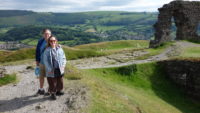 “Say,” says the attentive reader of Ye Olde Blogge. “I hate to tell you how to go about your business, but I can’t help but notice that there hasn’t been, you know, a whole lotta Wales in your Wales trip yet.”
“Say,” says the attentive reader of Ye Olde Blogge. “I hate to tell you how to go about your business, but I can’t help but notice that there hasn’t been, you know, a whole lotta Wales in your Wales trip yet.”
So true, but we fixed that today! We had breakfast with Dubbs in Lincoln, and then drove for about four hours to get to the small northern Welsh town of Llangollen (they have a two-for-one sale of the letter “L” going on). We got here about 2:00, so you would think that we wouldn’t get much touring done today. But you, dear reader, aren’t married to the Energizer Bunny of tourism.
We couldn’t get into our room until 4:00, so we jumped right into touring mode. The main parking lot next to our hotel was full, so I drove further up (and I mean up) Hill Street, which was one lane most of the way until I found parking on the side of the road. Mind you, it wasn’t terribly wide there either, but parking was legal. Why have two driving lanes on the road when you really only need one most of the time?
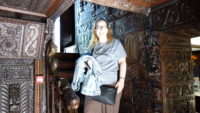 From there, we walked up Hill Street more to a side road, where we walked on to the grounds of Plas Newydd, a house that became famous from two ladies who lived there together for fifty years, from about 1780 to 1830. The two ladies (one of whom was a capital-L Lady) were ladies from Ireland who fled together to Wales. One woman was being pressured to go into a convent, and the other was attracting the eye of a married man in his fifties. The two women were friends and so decided to go live a retired life together with their maid, who helped them flee Ireland.
From there, we walked up Hill Street more to a side road, where we walked on to the grounds of Plas Newydd, a house that became famous from two ladies who lived there together for fifty years, from about 1780 to 1830. The two ladies (one of whom was a capital-L Lady) were ladies from Ireland who fled together to Wales. One woman was being pressured to go into a convent, and the other was attracting the eye of a married man in his fifties. The two women were friends and so decided to go live a retired life together with their maid, who helped them flee Ireland.
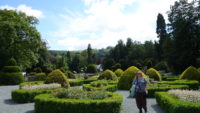 The women were seen as a bit eccentric, as they wore practical Irish clothing that was more masculine than normally seen in the area, but the locals seemed to enjoy them, especially as the ladies looked out for the village as best they could. The town has a popular hotel where horses were changed, and somehow word got around about the women, and so they ended up hosting many famous people including Sir Walter Scott and William Wordsworth (who wrote a poem specifically for the women). At some point, the ladies got obsessed with making their farmhouse appear to be Gothic, so they asked friends to send them anything that was of carved oak. It seems that carved oak was going out of style, so people sent the women pieces of furniture, carved chests, wall paneling, church décor, and so on. The women had it mounted on the front of the house, up the main staircase, and in other rooms. It is quite a visual display.
The women were seen as a bit eccentric, as they wore practical Irish clothing that was more masculine than normally seen in the area, but the locals seemed to enjoy them, especially as the ladies looked out for the village as best they could. The town has a popular hotel where horses were changed, and somehow word got around about the women, and so they ended up hosting many famous people including Sir Walter Scott and William Wordsworth (who wrote a poem specifically for the women). At some point, the ladies got obsessed with making their farmhouse appear to be Gothic, so they asked friends to send them anything that was of carved oak. It seems that carved oak was going out of style, so people sent the women pieces of furniture, carved chests, wall paneling, church décor, and so on. The women had it mounted on the front of the house, up the main staircase, and in other rooms. It is quite a visual display.
Outside the house, the grounds are lovely, with topiary out in the front and a woods walk down to a stream in back. We spent over an hour at the house and grounds.
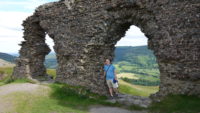 Down Hill Street we went, across a bridge over the River Dee and up another street to look into canal boat cruises. They were over for the day, but when Mer asked, the woman gave us instructions on how to hike up to the castle ruins above town, which I was pleased to do. The woman’s directions boiled down to “keep going up.”
Down Hill Street we went, across a bridge over the River Dee and up another street to look into canal boat cruises. They were over for the day, but when Mer asked, the woman gave us instructions on how to hike up to the castle ruins above town, which I was pleased to do. The woman’s directions boiled down to “keep going up.”
Up we went. There seems to be a theme of elevation going on in this town. It was about a mile and a half of up, counting switchbacks, but we took our time in the beautiful sunshine and stopped often to admire the unfolding views. When we did get to the top, we had a stunning panorama in any direction, as well as the castle ruins themselves.
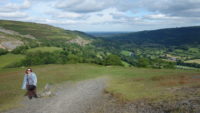 The poor people who built the castle. It seems that it was only inhabited for about twenty years back in the 1200s. Then the Welsh burned it down so that the English wouldn’t capture it and use it. The ruins are very picturesque, though.
The poor people who built the castle. It seems that it was only inhabited for about twenty years back in the 1200s. Then the Welsh burned it down so that the English wouldn’t capture it and use it. The ruins are very picturesque, though.
The views looked out over the Welsh mountains to the west, an escarpment of exposed rock to the north, more hills and a canal aqueduct to the east, and hills and the town to the south. We also had a fair amount of wind, but after the climb up, the cooling effect was welcome. We walked around the ruin for twenty or thirty minutes and then headed back down.
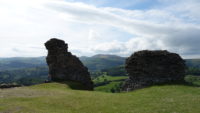 We checked in to our room and then got supper at a cafe on the river. By then it was 7:30, but there was still daylight plus sights unseen! So we went back up the far side of the Dee River, to the canal that is above the town, and we hiked the towpath back up the canal, 1.75 miles to the source where it splits from the Dee. There’s an artificial falls there shaped in a long arc that I think helps create a reservoir. It was a flat walk, but the river was pretty where we could see it near the end of the hike, and the canal was smooth and reflected the trees and bridges above it. It was a peaceful walk.
We checked in to our room and then got supper at a cafe on the river. By then it was 7:30, but there was still daylight plus sights unseen! So we went back up the far side of the Dee River, to the canal that is above the town, and we hiked the towpath back up the canal, 1.75 miles to the source where it splits from the Dee. There’s an artificial falls there shaped in a long arc that I think helps create a reservoir. It was a flat walk, but the river was pretty where we could see it near the end of the hike, and the canal was smooth and reflected the trees and bridges above it. It was a peaceful walk.
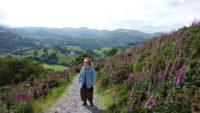 And so, after managing to cram thirteen miles of walking into a seven-hour touring day, we retired to our room. We’ll get to add more Wales to the Wales tour tomorrow.
And so, after managing to cram thirteen miles of walking into a seven-hour touring day, we retired to our room. We’ll get to add more Wales to the Wales tour tomorrow.